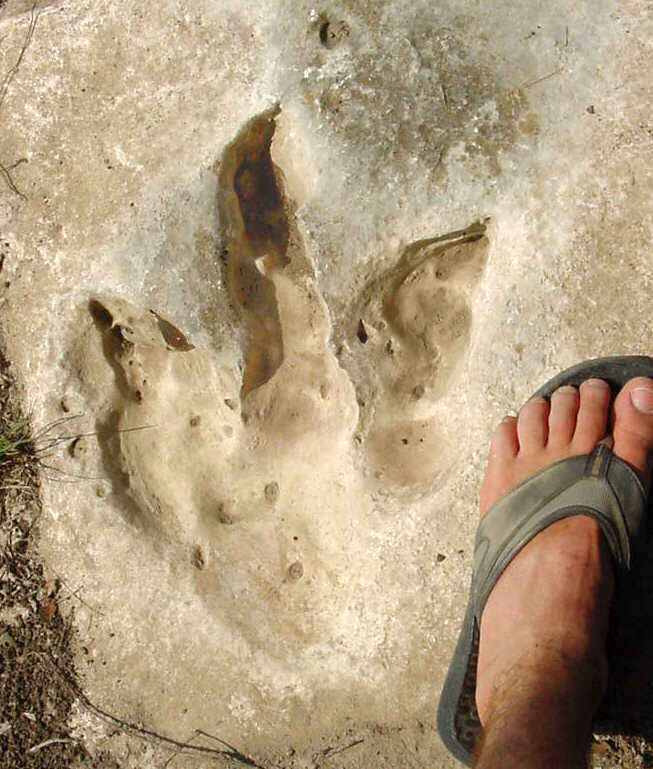
Edwards formation, Lower Cretaceous
(C) 2002, Glen J. Kuban
© 1994-2015, Glen J. Kuban,
E-mail gkpaleo@yahoo.com
Originally published in the April 1994 M.A.P.S. Digest,
Mid-America Paleontology Society, Rock Island, IL.
This web version includes additional illustrations and references.
Part of Kuban's Paluxy website

|
| Theropod
dinosaur track from central Texas Edwards formation, Lower Cretaceous (C) 2002, Glen J. Kuban |
Dinosaur tracks are remarkably abundant in many areas, and provide rich sources of scientific information on dinosaur behavior, locomotion, foot anatomy, ecology, chronology, and geographic distributions. Yet for many years dinosaur tracks were largely neglected by most paleontologists, who often seemed to view them as incidental curiosities. Fortunately, this attitude changed dramatically in recent years. The widespread revival of interest in dinosaurs has been paralleled by a renewed interest in dinosaur tracks. Today countless amateur and professional "trackers" are actively studying track- sites all around the world. New sites are being discovered at a rapid rate, and track studies are becoming more detailed and systematic as the scientific importance of tracks becomes more widely recognized.
Uncovering, documenting, and interpreting dinosaur tracks involves tools and techniques different from those applied to body fossils, but the basic principles can be learned and applied by anyone. Moreover, a number of excellent dinosaur track exhibits are now available to the public. Standing amid the footprints of these fantastic prehistoric beasts can be an exhilarating experience. Some trackways are so fresh- looking that it is not hard to imagine the trackmakers having strode by only moments before. Unless the fantasy of cloning dinosaurs becomes a reality, this is probably the closest we can come to standing beside a living, breathing dinosaur.
Fossilized dinosaur tracks are forms of trace fossils, also known as ichnites or ichnofossils. Unlike body fossils, which are the remains of dead bodies, trace fossils record the active movements and behaviors of ancient organisms. Besides footprints, trace fossils include fossilized burrows, dens, feeding tunnels, eggs, nests, stomach contents, coprolites (excrement), tooth and claw marks, and any other product or trace formed while an ancient organism was still alive. The study of trace fossils is known as ichnology. Some workers restrict the term to mean the study of fossil traces. Others include both modern and ancient traces, using the term paleoichnology to specify the study of ancient traces. At any rate, the study of modern traces often helps in interpreting ancient traces.
The terms track, print, footprint and footmark are often used interchangeably, although the first two include footprints as well as marks from other body parts, such as a tail, snout, or belly. A series of two or more consecutive tracks by the same animal is known as a trackway or trail.
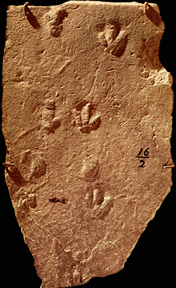
|
|
Noah's Raven" track slab found by Pliny Moody in 1802 The prints are referred to the ichnospecies Anomoepus scambus. The trackmaker is regarded as a small ornithopod. |
Native Americans probably knew of dinosaur tracks before the first European settlers. Ancient petroglyphs occur alongside several western tracksites. In fact, one site is known by an Indian name that translates, "location with bird tracks." The first authenticated dinosaur track discovery occurred in 1802 when a farm boy named Pliny Moody in South Hadley, Massachusetts, ploughed up a slab of reddish rock bearing several small three-toed footprints. The find was proudly displayed above a door in the Moody farmhouse, and a local doctor declared the prints to be those of Noah's raven. The confusion of dinosaur tracks with bird tracks was understandable. Dinosaurs were not yet known, and bipedal dinosaur tracks (especially small ones) bear a very close resemblance to bird tracks. The similarity is more than coincidental, since birds and dinosaurs are now considered close relatives.
By the late 1830's an intensive study of the fossil tracks of the Connecticut Valley was undertaken by professor Edward Hitchcock, president of Amherst College. Hitchcock systematically excavated, described, and classified thousands of tracks in remarkable detail, culminating in a monumental volume (Hitchcock, 1858), which is still a classic reference work in the field. Although Hitchcock believed many of the trackways were made by ancient birds, other trails puzzled him. Noting the occasional appearance of narrow, lizard-like tail marks, Hitchcock speculated that some of the trackways may have been made by large bird-like creatures with long, reptile-like tails. Without realizing it, he had just described dinosaurs.
By the time of Hitchcock's death, dinosaurs were better understood. However, most paleontologists soon became preoccupied with bones, and largely neglected dinosaur tracks for the next several decades. A notable exception was Richard S. Lull, who expanded and updated Hitchcock's work on the early Jurassic tracks of New England (Lull, 1915, 1953). Another exception was Roland T. Bird, who did extensive work on Cretaceous tracks near Glen Rose, Texas (Bird, 1941, 1953).
The neglect of dinosaur tracks came to an abrupt end in the early 1980's, when a veritable explosion of interest and research on dinosaur tracks occurred. In 1986 the First International Symposium on Dinosaur Tracks and Traces was held in Albuquerque, New Mexico, bringing together dinosaur trackers from all over the globe. The papers presented at the symposium were subsequently published in a book entitled Dinosaur Tracks and Traces (Lockley and Gillette, Ed. 1989). Subsequently two other books devoted to dinosaur tracks were published: Dinosaur Tracks, by Tony Thulborn (1990), and Tracking Dinosaurs, by Martin Lockley (1991). Each has a slightly different focus, but combined they provide a good review of modern dinosaur tracking.
Information from Dinosaur Tracks
Some of the most direct information available from dinosaur tracks concerns locomotion. Trackways can indicate whether a dinosaur was walking, trotting, running, or wading. They also show whether the animal was traveling in a bipedal (two-legged) or quadrupedal (four-legged) manner, or altering its gait between these modes. One can also calculate approximately how fast the trackmaker was moving. Additionally, tracks tells us how a trackmaker carried its tail, whether it walked with a narrow or sprawling gait, and in some cases, what posture the animal assumed while resting.
Inspection of individual prints provides data on the size and shape of the trackmaker's feet, and the number the toes. Clear prints can even reveal details of the soft anatomy of the foot, including the pattern of pads and muscles on the feet, and the flexibility of the digits. These track features, combined with trackway patterns, reveal important clues about the identity of the trackmaker.
Tracks also provide clues about the social behaviors of dinosaurs, and the environment in which they lived. Some sites contain dozens of parallel trails heading in the same direction, indicating a herding or migratory behavior. Often such trails seem to indicate the position of an ancient shoreline. Other sites indicate several herbivores clustered around apparent tree impressions, suggesting a feeding group. One interesting site has been interpreted by some as recording an ancient chase scene. Another site appears to record a dinosaur "stampede" (Thulborn, 1990).
Tracks also complement body fossils in providing information about geographic distributions of dinosaur groups, as well as their chronologic ranges. Knowledge of ancient ecology and population biology can also be expanded by studying dinosaur tracks. For example, researchers may tabulate the ratio of carnivore to herbivore tracks in a region, or the proportions of large to small trackmakers.
Rock strata from the Mesozoic era (Triassic, Jurassic, and Cretaceous periods) contain literally billions of dinosaur tracks, and actually outnumber bones by orders of magnitude. After all, a dinosaur could leave only one skeleton, but could make countless tracks during its lifetime.
Dinosaur tracks have been found in over 1000 locations throughout the world, on every continent except Antarctica. In the U.S., they are especially abundant in southern and western states, including Texas, Colorado, Utah, Arizona, New Mexico, as well as some eastern states, especially Connecticut, Massachusetts, and New Jersey. Most tracksites are found in quarries, mines, riverbeds, desserts, and mountain terraces--wherever Mesozoic strata are likely to be exposed. Paleontologist Martin Lockley notes that in the western U.S. alone new sites are being reported at the rate of about 50 per year (Lockley, 1991). Of course, the original settings in which the tracks were made were considerably different from the modern ones. Most tracks were made in the kinds of places one commonly sees tracks today: near shorelines and tidal flats, where large expanses of moist sediment are found.
Unlike body fossils, which often are best preserved when they are buried rapidly, tracks are more likely to be well preserved when they are buried in a relatively slow, calm manner. For this reason, tracks and bones are seldom found in close association.
There are two main ways in which tracks can be formed and preserved. The classic scenario is as follows. First, a trackmaker walks along a moist but firm, fine-grained sediment. Then the tracks remain exposed for a short while, allowing them to become drier and harder (and thus able to resist damage during subsequent burial). A short time later the prints are gently buried with additional sediment, preferably of a contrasting type (which would allow the layers to separate when later reexposed). While buried for millions of years, the original sediment lithofies (turns into rock). Finally, the tracks are reexposed in modern times by erosion or other forces. Of course, the tracks also must be found and studied before they are destroyed by weathering, quarry workers, or other dangers. Tracks formed under less ideal conditions tend to be distorted or indistinct, if preserved at all.
Recent research suggests another mechanism of print formation, which involves a dinosaur walking on a very soft surface. In such a case, the animal's feet may push into firmer layers below the surface. The soupy surface material may then rush back over the upper depressions, simultaneously covering the prints made in the lower layers. The subsurface prints are known as underprints, undertracks, or ghost tracks. Because they are buried as soon as they are made, any erosion or other destructive forces occurring at the surface would pose no threat to them, increasing their chances of being preserved.
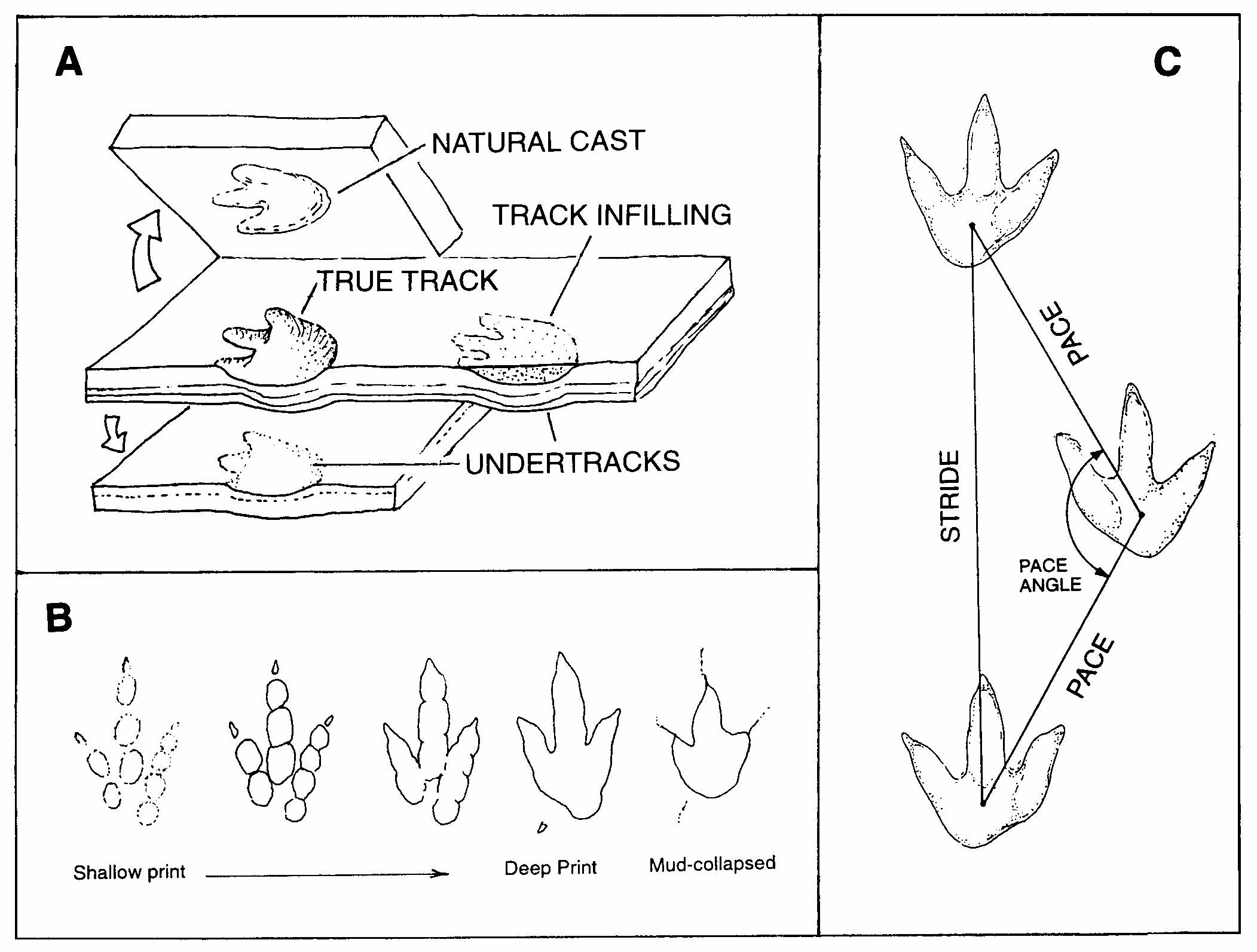
A. Track Formation and Preservation
Diagram showing a true track, natural
cast, undertracks, and track infillings as they might
appear in rock strata. Adapted from Lockley (1991).
B. Track Variations Related to Sediment Consistency.
All the tracks shown were made by a single dinosaur stepping on
substrates of different concistencies, with the firmer substrates
at left and the softer ones on the right. Notice the absence
of distinct pads in the deeper prints (at right). The right-most
track suffers from "mud collapse" or "mud back-flow," where soft
sediment slumps back into a track depression, distorting its shape.
Adapted from Thulborn (1990).
C. Basic Trackway Measurements.
Pace angles (also called step angles or pace angulations) may be
calculated using trigonometry once pace and stride measurements
are made. On a quadruped trackway, these measurements should be made for
both rear and front prints. One should also measure individual print
lengths, widths, depths, and digit dimenstions and angles.
Besides the variables of initial formation, tracks are often affected by a number of other factors that can alter or distort their shapes and sizes. Trackers should be aware of these factors in order to avoid misinterpretations and misindentifications.
Often major differences in track shape or features can result from variations in the consistency of the substrate. The best tracks are made on sediment that is neither too firm nor too soft. When a track is made on very soft substrate, some sediment may slump back into the print. This phenomenon, called mud-collapse or mud back-flow, often distorts and reduces track features. Digit marks may become mere slits. Soft sediment can also result in undertracks, as described earlier. On the other hand, if the substrate is very firm, portions of the foot may record only lightly, if at all.
Another common factor affecting track appearance is erosion and weathering, which can occur in both ancient and modern times. Erosion can distort or blur track features or even obliterate them. It can also create depressions of its own, which are sometimes mistaken for fossil tracks.
Track features may also be obscured by infillings, which occur when an overlying layer is largely scoured away, but remains trapped in some of the track depressions. Well-infilled tracks may exhibit little or no topographic relief. On some sites entire trackways of infilled tracks were missed for decades. Only when the substrate was thoroughly washed were the infillings revealed by virtue of their contrasting color and texture from the surrounding substrate (Kuban, 1989b).
In other cases a series of thin laminations may completely cover a track bed, but still reflect the contours of tracks below. These upper layer depressions are known as overtracks. Like undertracks, they may be mistaken for "true tracks" on the original surface. Edward Hitchcock wired together a kind of stone book made from a stacked sequence of thin track plates--all from the same footstep. The "pages" toward the front and back of the book (representing overtracks and undertracks) are less distinct than those in the middle, but it is difficult to determine exactly which plate was the original track layer. One can be more confident that a print was made on the original track surface if it overlaps with lithofied mud cracks, ripple marks, or rain drops. In one special case one can be sure a track was made on the original surface: when it shows scale impressions from the dinosaur's foot. Unfortunately, only a few tracks with clear scale impressions are known.
Tracks are usually thought of as an indented impressions. However, they can also consist of natural casts from overlying or infilling material --showing the opposite relief of an indented track. Irregular foot movements such as slips and slides can also create unusual shapes, especially when combined with other variables. Indeed, most tracks are a product of foot shape and movement, combined with at least some of the other factors noted above. Sorting out these variables is part of the challenge of tracking. Many dinosaur tracks have been misidentified or misinterpreted based on poorly preserved specimens, or a failure to recognize one or more variables affecting print appearance.
It is often difficult or impossible to identify the particular genus or species of dinosaur that made a given trackway. However, one can usually determine at least the general group of dinosaurs to which the trackmaker belonged, since foot structures vary considerably among different dinosaur groups. In many cases the locomotor styles of different groups varied as well.
Paleontologists divide dinosaurs into two main groups based largely on hip structure: Orithischians and Saurischians. However, when dealing with tracks, it is more convenient to first determine whether a trackmaker is bipedal or quadrupedal (Ornithischians and Saurischians both included bipedal and quadrupedal members).
Bipedal trackways are the most common. They contain left-right sequences of similarly shaped prints, each containing three major digit marks. They are commonly called "three-toed tracks" or tridactyl tracks. Most bipedal dinosaurs actually possessed four digits on each foot, but one digit (the hallux) was small and held in an elevated position at the inside rear of the foot. When recorded at all, hallux marks are usually small and shallow.
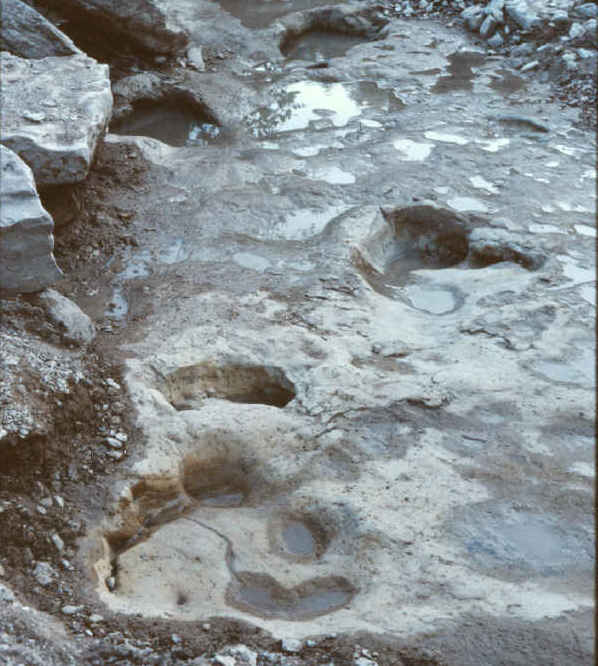
|
|
Brontopodus birdi Sauropod Trail Lower Cretaceous Glen Rose, Texas |
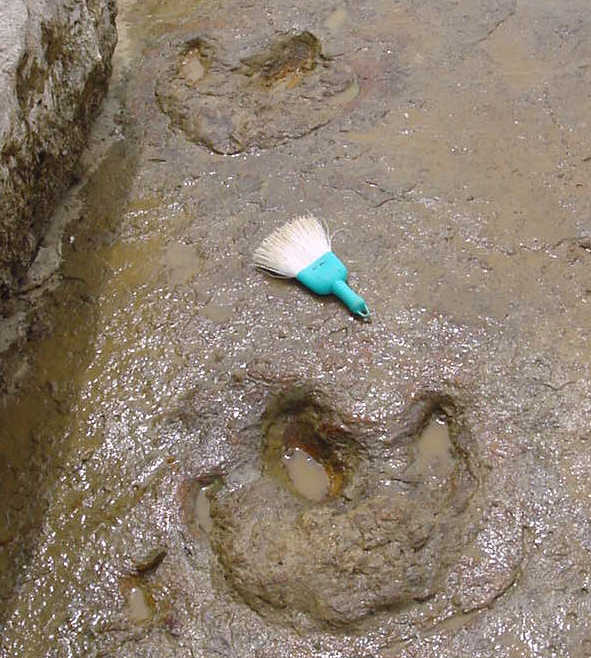
|
|
Carirchnum sp. Ornithopod Trail Lower Cretaceous. Grapevine, TX |

|
|
Grallator Theropod track Lower Jurassic Connecticut Valley, Mass. |
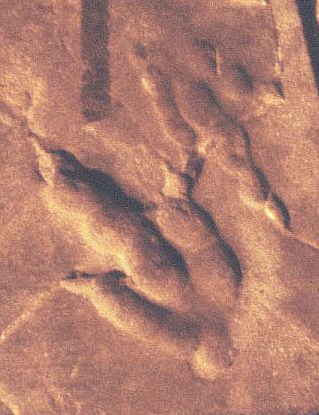
|
|
Anchisauripus sp. theropod track Lower Jurassic, Connecticut Valley, Mass. |
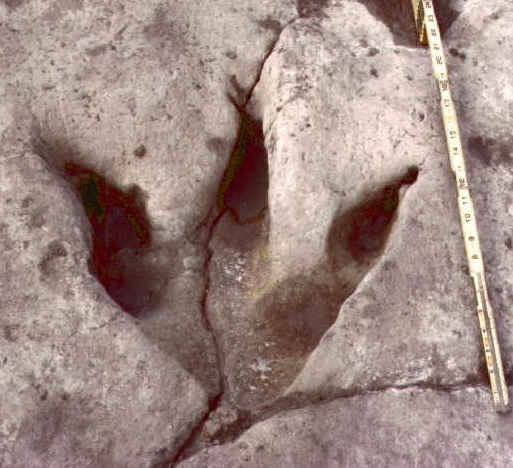
|
|
Eubrontes sp. carnosaur track Lower Cretaceous Glen Rose, Texas |
Dinosaurs that made bipedal tracks fall into two
major groups: theropods (bipedal meat-eating dinosaurs)
and ornithopods (bipedal plant-eating dinosaurs).
Theropod tracks typically exhibit relatively long and
narrow digit impressions, terminated with sharp,
slender claw marks. The posterior ends are typically
somewhat V-shaped. Among theropods, a somewhat
arbitrary division is made between small, gracile forms
called coelurosaurs, and large, robust forms known as
carnosaurs. Coelurosaur tracks often exhibit digits
held closely together, and distinct toe pads. The
shapes and positions of the pads are useful in
identifying particular ichnogenera. The digit marks of
carnosaur tracks are often more widely splayed and
robust, with less distinct pads.
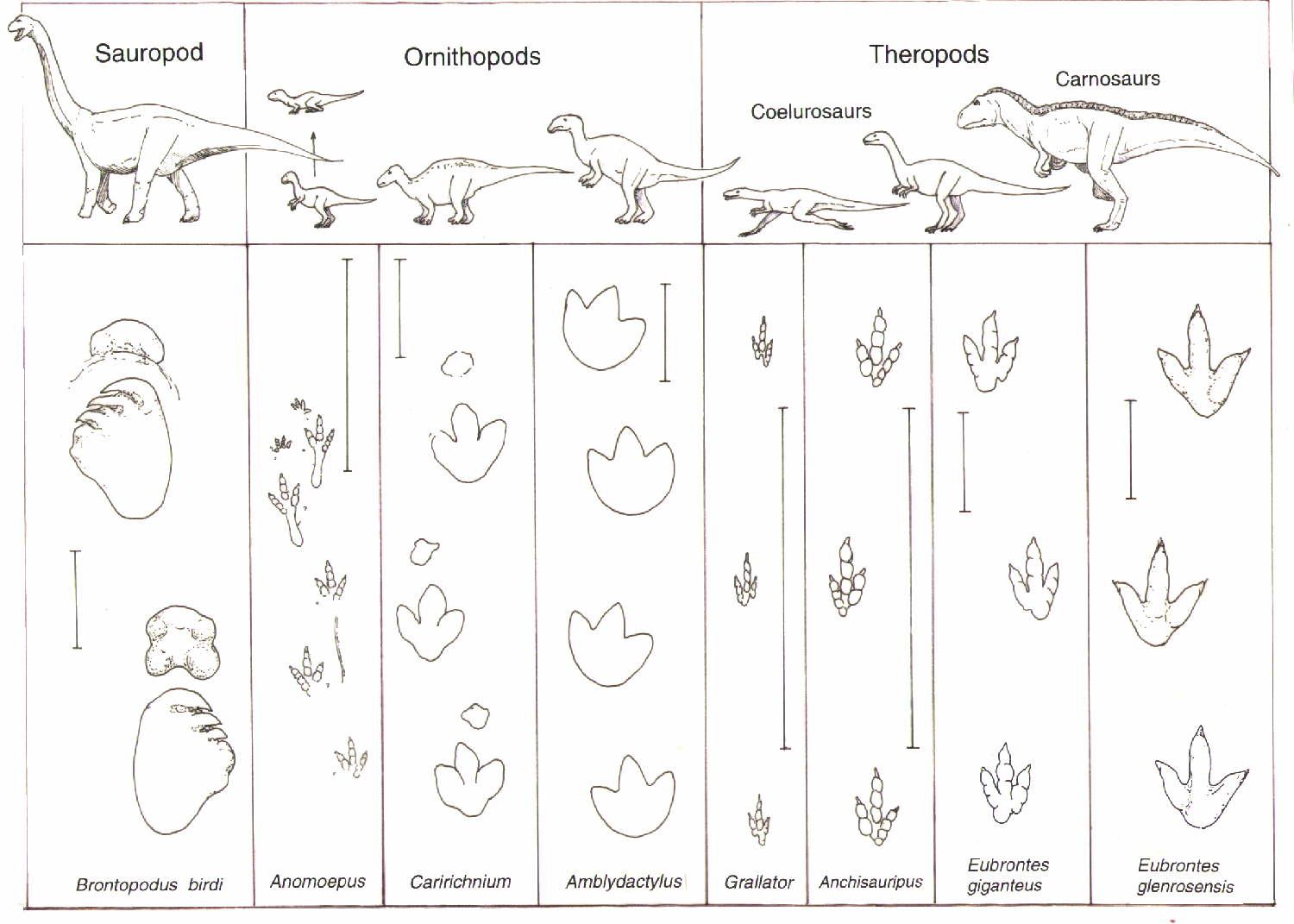
Scale bars = 50 cm. Tracks represented are typical sizes for each ichnotaxon
A. Brontopodus birdi. Sauropod tracks from the Lower Cretaceous Glen Rose Formation, Texas.
B. Anomoepus.. Small ornithopod from the Lower Jurassic of the Newark Supergroup, Connecticut Valley
C. Carirchnum. Tracks of an iquanodont or other large ornithopod. Lower Cretaceous, Colorado
D. Amblydactylus. Large Ornithopod tracks, possibly Hadrosaur, Lower Cret, British Columbia
E. Grallator. Attributed to a small, fast running coelurosaur. Lower Jurassic, Massechusetts.
F. Anchisauripus. Medium sized theropod tracks, Lower Jurassic, Massachusetts.
G. Eubrontes giganteus. Lower Jurassic carnosaur tracks, Massachusetts.
H. Eubrontes glenrosensis. Large carnosaur (Acrocanthosaurus) tracks, Lower Cretaceous, Texas,
Ornithopod tracks are normally wider than theropod tracks, with well rounded posteriors and relatively short, blunt digit marks reflecting hoof-like claws. However, the distinction between ornithopod tracks and theropod tracks is less clear-cut in some small and poorly preserved tracks. Even experienced trackers debate whether small tracks represent ornithopods or theropods, and whether they represent small species or merely juveniles of larger species. Also, carnosaur tracks can be mistaken for large ornithopod tracks when their digits are partially mud-collapsed, causing them to appear shorter and blunter, and thus more ornithopod-like.
Both theropods and ornithopods habitually walked in a digitigrade (toe-walking) manner. Until recently it was assumed that they always did so. However, my research in the Paluxy Riverbed of Glen Rose, Texas during the early 1980's (and later in collaboration with Ron Hastings), showed that some bipedal dinosaurs at least occasionally walked in a plantigrade or plantigrade- like manner, impressing their soles and heels as they walked--thus making elongate tracks. Why they sometimes did this is uncertain. One idea relates to a lowered or 'crouching' body position--perhaps during a foraging or stalking behavior--which would force the metatarsus into a more horizontal position. Incidentally, when the digit impressions of metatarsal tracks are subdued by erosion, mud collapse, or a combination of factors, they often resemble giant human tracks, for which they were mistaken by many locals and strict creationists. The latter often cited such tracks (along with erosional markings and some loose carvings also promoted as "man tracks") in attempts to demonstrate dinosaur and human cohabitation, and thus refute evolution. However, most "man track" advocates backpedaled from their claims after detailed explanations of the metatarsal tracks and related phenomena were published. (For further discussion on this topic see "Elongate Dinosaur Tracks" (Kuban, 1989).
Ironically, not only do the Paluxy tracks provide no evidence for strict, young-earth creationism, but when carefully examined, they and other trace fossils (including vast dinosaur nesting sites) are seen to be among the many lines of geologic evidence that convincingly refute young earthism and demonstrate a long and complex earth history (Kuban, 2006).
Quadruped dinosaur tracks are far less common than bipedal tracks, although at Paluxy and a handful of other sites, tracks of four-footed, long necked sauropods (informally called "brontosaurs" are common. Most other quadruped dinosaur tracks are rare, prossibly because the trackmakers preferred dry or wooded habitats, where their prints would not be preserved. Quadruped tracks generally show rear and front prints of different sizes and shapes, with the rear prints larger than the front prints. Both the front and back feet of quadruped dinosaurs can have as many as four or five digits.
Sauropod tracks are not only the most common form of quadruped dinosair tracks, but also the most spectacular. Some sauropod prints are over a meter long and as deep as bathtubs. Until recently only a handful of sauropod tracksites were known, but today several dozen locations are known worldwide. Those in and around Glen Rose, Texas are among the most famous and best preserved. Roland Bird and his crew cut out a large set of these tracks, which are on display at the American Museum in New York. Many others are still visible in the riverbed when the water level is low (typically July through September). One interesting feature of Bird's sauropod trackways is that a set of large carnosaur tracks parallels the sauropod tracks, leading many (including Bird himself) to speculate that they record an ancient chase scene. Others point out that the paces are rather small and show unhurried gaits --suggesting that the carnosaur may have been stalking the sauropods from a distance, or simply using the same path.
The rear feet of sauropods contained five digits, decreasing in size from the inside toward the outside of the foot. The inner three or four digits (depending on the species) bore large claws, which record well in tracks, and which angle toward the outside of the foot (despite contrary depictions in some books and skeletal mounts). The fourth and fifth digits were generally small and clawless, and seldom record well. The overall shape of the rear prints is often somewhat bear-like, although others (even within the same "herd") are almost triangular, perhaps reflecting an age or sexual difference.
The front (manus) prints of sauropods resemble elephant tracks. Well-preserved specimens show evidence of five blunt, peglike digits: two on each side and another embedded in a fleshy pad at the anterior end. Often the front prints were overlapped by the rear prints (or mud pushed forward by them), reducing the front prints to crescent-shaped depressions, or obliterating them altogether. One mystery is why the front prints show only blunt digits marks, whereas skeletal remains of sauropod front feet include a large pointed claw. One idea is that the single claw was held in an elevated position. Another is that the claw was tucked within the fleshy pad at the front of the foot.
Other types of quadruped trackways are less well known. Some are attributed to iquanodonts, which sometimes alternated between bipedal and quadrupedal gaits. Their rear feet contained three wide, blunt digits like most other large ornithopods, and their front feet bore five digits of varying length. Many tracks attributed to iquanodonts show a strong inward (pigeon-toed) rotation of the feet. Only a few trackways are attributed to ceratopsians and ankylosaurs. Both were habitual quadrupeds. The feet of ankylosaurs were somewhat more robust and compact than those of ceratopsians, but otherwise their feet were similar--each having four digits on the back feet and five on the front feet. Only a few tracks have been attributed to stegosaurs, but even these do not closely match the foot bones of known stegosaur foot skeletons.
Although determining the group of dinosaurs associated with a trackway is often straightforward, identifying a particular dinosaur genus as the trackmaker is much more difficult. Within each group many dinosaurs had similar feet, and many foot skeletons are poorly known (or missing altogether). Moreover, as noted above, footprints are often the result of many factors beside foot shape.
For these reasons, ichnologists have often given names (called ichnotaxa) to the track forms themselves, apart from body fossils. An ichnotaxon (ichnofamily, ichnogenus or ichnospecies) refers only to the shape and features of the track. They should not be confused with the names of the actual trackmakers. Often track names end in "pus" or "podus", referring to feet.
Ichnotaxa can be very useful--allowing workers to discuss and recognize various track forms whether or not the trackmakers are known. However, track names should be created and applied with care and moderation. Some early workers tended to create many new names based on insignificant or or highly variable track features such as print size or pace length. In order to bypass the existing complexity, some modern workers tend to lump most tracks into a handful of popular ichnogenera. This is convenient, but tends to replace excessive complexity with oversimplification. Other researchers are reevaluating many old names. Although not all workers agree on the criteria that should be used to name tracks, most would urge that the names be based on clear specimens and meaningful features. I agree, and recommend that the following specific criteria be met before a new track name is created, or an old one validated:
If these principles are followed in evaluating old names, the names that remain will be more meaningful and useful. A good example of the proper way to name tracks was recently demonstrated by James O. Farlow, Jeff Pittman, and J. Michael Hawthorne. They illustrated the distinctive features of the Paluxy River sauropod tracks with clear descriptions, maps, and diagrams, and named the tracks Brontopodus birdi. The generic name Brontopodus is based on an early suggestion by Roland Bird, and the specific name birdi honors Bird himself (Farlow et al, 1989).
Despite the difficulties of identifying particular dinosaur species or genera as trackmakers, sometimes such identifications can be made at least tentatively. Normally this requires that the tracks contain clear and unique features matching equally distinctive features on a foot skeleton, or that the tracks provide a good fit to skeletons found in close association with a tracksite. The Glen Rose sauropod tracks were often tentatively associated with the sauropod Pleurocoelus, since skeletal remains of that dinosaur have been found in nearby strata of the same age. However, in 2007 these bones were reevaluated and assigned to a new sauropod genus: Paluxysaurus (Rose, 2007), and has since been declared the official state dinosaur by the Texas legislature.
Likewise, the large theropod tracks in Glen Rose have been attributed to Acrocanthosaurus, a medium sized carnosaur whose bones were found in rocks of similar age in Oklahoma and Texas (one skeleton was found only a few miles from the tracksites). In order to learn as much as possible about a trackmaker and its environment, a tracksite must be cleaned and documented thoroughly, as outlined below.
As preparation for serious tracksite study, one should research any prior scientific literature on the site and the geology of the region, to get an idea of what is already known. One should also obtain permission from the owners or controllers of the site for whatever is work is planned.
In most cases tracks should be studied and documented in situ (in place), rather than being removed. After all, one advantage in studying tracks is that they are usually intact and still in their original positions, rather than being scattered and broken, as is often the case with bones. Attempting to remove dinosaur tracks often turns them into similarly damaged specimens, and in most locations is illegal. Removing tracks also prevents other workers from studying them in their proper context with other trails and surrounding features. Moreover, modern casting methods allow tracks to be replicated with extreme precision, eliminating the need to remove specimens. Exceptions are sometimes made for sites in imminent danger of destruction. Even in such cases, track removal should only be attempted by groups with proper tools and expertise, and with permission of the site owner.
The main object of site preparation is to clean the track surface well. This may entail merely brushing off superficial sediment, but more often will require removal of larger amounts of sand, gravel, water, or even overlying rock layers. The tools required to do this will vary with the type and amount of overlying material and the scope of the study. A basic set of equipment includes shovels, hand trowels, brooms, buckets, brushes, sponges, measuring devices (tape measure, meter stick, protractor, paper and pencil), photographic equipment, mold-making materials, and clean-up supplies. Of course, always keep a first aid kit handy. When working in a riverbed, sandbags may be useful. One should estimate how much can be cleaned and studied in the time available. It is generally best to leave tracks buried if they are not going to be worked on immediately. Once exposed, tracks are more susceptible to erosion, vandalism, and other hazards.
Cleaning the tracks surface as thoroughly as possible ensures that subtle but potentially important track features are not missed. However, care should be taken to avoid damaging the track bearing surface, especially when using metal tools such as shovels and pry bars. Final removal of superficial sediment (and any material within deep depressions) should be done with less destructive tools such as brooms, wisk brushes, plastic trowels, and hand scoops. A moist sponge is often ideal for final cleaning. Special care is needed where the track surface is coarse or friable, or when the overlying layer does not separate easily from the track bed. Small nooks and crannies in tracks should be cleaned out with brushes and other small implements, preferably made of plastic or wood rather than metal.
After a site is well cleaned, each track should be marked with an identification number, to be used in subsequent mapping and photography. Generally, it is best to mark the numbers with removable paint or chalk, rather than with permanent paint (since other workers may want to use other numbering schemes, and casual visitors may wish to view and photograph the tracks later without distracting markings). One of the easiest and simplest numbering methods is to assign a number to each trackway, and then assign each track in the trail a number following the letter. For example, Trail "A" would contain tracks A1, A2, A3, and so on.
Photographs are an important part of site documentation, and a valuable aid in site mapping. Photos should be taken after the tracks are well cleaned, preferably in morning or late afternoon light, which brings out subtle track features. The most scientifically useful photos are close-ups of individual clear specimens (taken from directly above, rather than to the side), and high overhead photos showing multiple tracks in succession. For high shots, ladders or cameras mounted on extension poles are often useful. Supplemental photos may include oblique shots of various tracks and trails to help depict track contours and depth. For scientific purposes, the photos should include the identification numbers discussed above and a meter stick or other familiar object for scale. Some workers like to highlight tracks with water during photography. Although this helps increase the contrast of the tracks against the surrounding substrate, one should be careful not to create the illusion of depth or contours that are not clearly recorded in the tracks themselves.
Good site documentation requires detailed measurements of trackways and individual tracks. Ideally the entire site should be mapped; however if time does not permit this, focus should be on the clearest tracks and trackways. Important track measurements include length, width, and depth. Because there are several possible ways (and no universal standard) to take such measurements, it is crucial that authors describe and illustrate exactly how they were taken. Other useful track measurements include their directions (usually taken in relation to magnetic north), the total digit divarication (angle made between the outermost and innermost digits).
Key trackway measurements include pace, stride, and pace angle (Figure 1, diagram C). The terms "pace" and "stride" were often used inconsistently in the past. However, today the term pace (or step) refers to the distance from one footprint to a corresponding point on the next succeeding print (in other words, from a right to a left, or a left to a right). The stride is the distance from one footprint to a corresponding point on the next print of the same foot (say, from a right to the next right print). Pace angle (the same as step angle) is the angle formed between two successive paces. For a quadruped trail, separate pace, stride, and pace angle measurements should be taken for the front and rear prints. Long measuring rods such as two-meter sticks are useful for taking pace and stride measurements. While taking these measurements, a consistent reference point should be marked on each track. Some authors use the posterior-most or anterior-most point of each track, but since these points vary considerably on indistinct tracks, I prefer to use a more central point, such as the base of the middle digit. Whichever method is used, it should be clearly spelled out. Once pace and stride measurements are made, pace angles can be calculated using trigonometry; however, if time permits it is best to take direct stride measurements, which serve as a check on pace and pace angle measurements.
Other useful trackway measurements include trackway width and track rotation--the degree to which individual tracks are turned inward ("pigeon toed") or outward ("duck-footed"). These measurements are usually taken in reference to the trackway centerline. Measuring the total length of a trackway gives a good check on the accuracy of pace and stride measurements. If more than one trackway occurs on a site, the distance between the trails at different points should be measured.
Constructing a chalk or string grid can greatly assist overall site mapping. After the grid is laid out on the site, it is fairly easy to sketch all tracks and trails on grid paper. When combined with photographs and measurements, an accurate site map can then be drawn. The mapping process can be greatly sped up by using high-overhead photography of trackway sections on such a grid. One method is to mount a camera on a tall pole (with the aid of a timer or remote control device), and levels to insure that the aim is consistently perpendicular to the track surface. Successive photos of trackway sections can be stiched together with photo editing software, and traced to produce accurate trackway diagraams, However, taking at least a number of direct measurements of trails and indivudal tracks are still useful as checks, as are direct overhead close-ups of indiviual tracks.
If track site conditions allow, another quick mapping technique involves stretching a large sheet of transparent plastic across the track surface, onto which the tracks are traced. However, because the plastic will not conform exactly to the track surface, and tend to move somewhat even when the ediges are well achored, the tracings will be less exact than direct measurements or good overhead photos on a grid.
More modern methods increasingly used for site mapping include the use of aerial "drones" armed with high-fidelity cameras, and remote digital sensing technology such as "Lidar" that measures distance by illuminating a target with a laser and analyzing the reflected light. However, be aware that in many areas drones are subject to regulations and permit requirements.
Molds and casts are excellent means to make permanent records of choice specimens. Before doing any mold making, be sure to secure permission from the site or specimen owner. Workers differ on whether an impression taken directly from a track should be called a mold or a cast. Assuming the track is indented, a direct impression of it can be viewed as a rough cast of the dinosaur's foot, since the track is a type of natural mold. However, if one views the track itself rather than the foot as the original specimen, then any direct impression taken from the track is a mold of the track, and any replicas made from the mold are casts. The latter usage is most common, and will be used here.
Common mold-making materials include plaster, latex rubber, and silicone. Plaster is quick and easy to use, but should only be applied to smooth, hard tracks lacking undercuts, and only with the application of a release agent such as petroleum jelly. Otherwise, the mold may become stuck in the track. Plaster molds are also heavy and brittle, and record less detail than rubber molds. Liquid latex rubber yields lightweight, flexible molds, and requires no separating agent. The latex is brushed on in several layers. Embedding open-weave cloth between layers makes the mold stronger and sturdier. However, even with reinforcement latex molds tend to be "floppy," and when made from deep tracks, the molds should be supported with a rigid backing or "mother mold." The backing can be made of plaster, fiberglass, or expandable urethane foam. Always pull up and then reposition a latex peel before applying a rigid backing (otherwise the mold will be difficult to remove from the print).

|
| A "sprinting" trackway of a theropod dinosaur, with an average pace of 1.81 meters, and a stride of 359 cm (over 11.5 feet). Likely trackmaker: Acrocanthosaurus atokensis. Park NE site, Dinosaur Valley State Park, Texas, Lower Cretaceous, Glen Rose Formation. Long striding trackways like this (of which a few others are known in Texas) seem to demonstrate that at least moderate sized or adolescent carnosaurs could definitely "run." (C) 1988, Glen J. Kuban |
Silicone rubber also produces light-weight, flexible molds. It is available in two-part compounds (a base and a catalyst) that are mixed together and poured onto the specimen. Silicone molds are somewhat sturdier than latex, resist decay better, and can be made in a shorter period of time if certain "fast" catalysts are used. However, silicone is more expensive than latex, and requires the use of a separating agent. Also, if the specimen is deep, the mold should be supported with rigid backing. Once a mold is made, a cast can be made using a rigid material such as plaster or fiberglass. A well made mold or cast will record the finest details of a track, allowing specimens to be studied, handled, and displayed without risk of damage to original specimens.
Naturally, if a site study is published, all of the data gathered should be compiled in a clear format, along with a complete and accurate site map. Although measurements are important and should be included, an accurate site map allows readers to grasp the essential features of a tracksite more readily than pages of statistics.
One popular exercise using trackway measurements is to estimate the speed of the trackmaker. Generally, if the pace distance is four or more times the track length, one can describe the gait as "running." The estimated speed of travel can be calculated using formulas developed by R. M. Alexander and others (Alexander, 1989). Most dinosaur trackways indicate unhurried gaits of 2 to 12 km/hr. However, several bipedal trails indicate speeds of over 40 km/hr (about 25 mph)--faster than a human sprinter. Evidently many dinosaurs were capable of running, even though they seldom did so. This is not surprising; even the fastest animals spend very little of their time running.
Digitigrade locomotion and narrow trackways (both common features of bipedal dinosaur trails) are also interpreted as signs of cursorial animals and efficient locomotion. Some bipedal trackways are so narrow that the tracks almost form a straight line. The small digit divarication typical of small theropod tracks is also indicative of agile animals. Overall then, track evidence suggests that bipedal dinosaurs went about their business at a leisurely pace most of the time, but were capable of running fast when the need arose. These conclusions coincide well with recent work on dinosaur anatomy and biology. Even sauropod trackways are relatively narrow in comparison to reptiles such as lizards or turtles. It is unlikely that sauropods could run (no running sauropod tracks are known), but they may have been able to trot like elephants.
After decades of neglect, the study of dinosaur tracks has blossomed into a mature, dynamic, and respected branch of mainstream paleontology. As more of these fascinating prehistoric trails are uncovered, there is no telling where they will lead, or how far they may take us in our efforts to learn more about dinosaurs and their ancient world.
For those who wish to visit an actual tracksite, a good place to start is at one or more of the excellent exhibits protected and prepared for public viewing, a number of which are listed below.
All of the locations listed below include some form of interpreted track display. Several show tracksites still in their original locations.
Dinosaur State Park , Rocky Hill, Connecticut. A large tracksite still in its original position, but entirely enclosed in a modern display center. An elevated, circular balcony surrounds the dramatically lighted track floor, which is covered with hundreds of theropod tracks, most of which represent the ichnogenus Eubrontes. Surrounding the tracks are interpretive displays and track replicas from other areas. Several excavated tracks are set aside in an outdoor courtyard, where visitors are allowed to make molds.
Pratt Museum , Amherst College, Amherst, Mass. The basement of Pratt Museum houses the famous Hitchcock collection, featuring thousands of lower Jurassic dinosaur tracks from the Connecticut Valley of New England. Most were collected by Edward Hitchcock during the 1800's, including many type specimens. It is probably the world's largest and most important dinosaur track collection. 2005 Note: The Pratt Museum closed in 2004, and is being moved to a new natural history museum at Amherst College. It is scheduled to open in 2006.
Holyoke Site, Holyoke, Mass. A natural tracksite located along the Connecticut River, marked with a an interpretive sign. Although the tracks have eroded somewhat since their first exposure decades ago, many are still recognizable. Most are identified as the ichnogenus Eubrontes, although some small tracks (either Grallator or Anchisauripus) also occur there.
Dinosaur Valley State Park, Glen Rose, Texas. The park is situated along the Paluxy River, just west of Glen Rose, Texas. When the river is low, one can see many large Cretaceous carnosaur and sauropod tracks still in their original positions. Park personnel try to keep an area of distinct tracks cleaned off, but visitors may wish to bring their own broom to sweep out additional tracks. A visitor center at the park entrance includes interpretive displays and trackway replicas. This author's website on dinosaur valley shows several photos of trackways in the park.
American Museum of Natural History , New York. Features a remarkable display of Cretaceous sauropod and carnosaur tracks excavated by Roland Bird from the Paluxy Riverbed. Mounted above the trackway is a Apatosaurus excelsus skeleton, which is not the dinosaur that made the tracks, but a similar sauropod.
Clayton Lake State Park, Seneca, New Mexico. A large tracksite still in its original position, containing hundreds of ornithopod and theropod tracks. Included are infilled specimens and metatarsal tracks, as well as a few tail impressions. Elevated walkways over the track bed allow easy viewing.
Tuba City Site, Arizona. Located on a Navajo reservation 5 miles west of Tuba City, along highway 160 (not far from the Grand Canyon), this natural site contains many lower Jurassic theropod tracks. Navajo children often serve as informal guides.
Alameda Parkway (Dinosaur Ridge) , Denver Colorado. Located along the Alameda Parkway road just west of Denver are several Cretaceous dinosaur trackways still in their original position.
Skyline Drive Trackway, Canon City, CO
Dinosaur Valley Museum of Western Colorado, Grand Junction, Co. Displays a variety of dinosaur tracks and some interpretive displays. Nearby are other interesting dinosaur exhibits.
Tyrrell Museum of Paleontology , Alberta, Canada. Houses a vast collection of dinosaur tracks from the Peace River of British Columbia, some of which are on display, along with one of the largest exhibits of dinosaur skeletons.
The College of Eastern Utah Prehistoric Museum , Price, Utah. Displays include about 50 Cretaceous dinosaur tracks (mostly ornithopod tracks) collected from coal mine roofs.
Alexander, R. M. 1989. Dynamics of Dinosaurs and Other Extinct Giants. Columbia University Press, New York.
Bird, R. T. 1941. A Dinosaur Walks into the Museum. Natural History, 47: 74-81.
Bird. R. T. 1953. We Captured a Live Brontosaur. National Geographic, 105 (5): 707-22.
Bird, R. T. 1985. Bones for Barnum Brown: Adventures of a Dinosaur Hunter. Texas Christian University Press, Fort Worth.
Farlow, J. O. 1981. "Estimates of the Speeds of Dinosaurs from a New Trackway Site in Texas," Nature, London, 294: 747-8.
Farlow, J. O. 1987. A Guide to Lower Cretaceous Dinosaur Footprints and Tracksites of the Paluxy River Valley, Somervell County, Texas. Baylor University, Waco, Texas.
Farlow, J. O. 1993. The Dinosaurs of Dinosaur Valley State Park. Dept. of Geosciences. Indiana- Purdue University at Fort Wayne, Fort Wayne, IN.
Farlow, J. O., J. G. Pittman, and J. M. Hawthorne, 1989. Brontopodus birdi, Lower Cretaceous Sauropod Footprints from the U.S. Coastal Plain. In Dinosaur Tracks and Traces (D.D. Gillette and M.G. Lockley, Eds.). Cambridge University Press, Cambridge, 371-94.
Frey, R. W., Ed. 1975. The Study of Trace Fossils. Springer-Verlag. New York.
Gillette, D.D. and M. G. Lockley, editors. 1989. Dinosaur Tracks and traces. Cambridge Uni versity Press, Cambridge, England.
Hitchcock, E. 1958. Ichnology of New England. A Report on the Sandstone of the Connecticut Valley, Especially its Fossil Footmarks. W. White, Boston. Reprinted 1974, by Arno Press, New York.
Kuban, G. J. 1986. A Summary of the Taylor Site Evidence. Creation/Evolution, 6 (1): 10-18.
Kuban, G. J. 1989. Elongate Dinosaur Tracks. In Dinosaur Tracks and Traces (D.D. Gillette and M.G. Lockley, Eds.) Cambridge University Press, Cambridge, 57-72.
Kuban, G. J. 2006. Fossil Tracks and Other Trace Fossils Falsify Flood Geology. Web article at: http://paleo.cc/ce/tracefos.htm
Kuban, G. J. 1989. Color Distinctions and Other Curious Features of Dinosaur Tracks Near Glen Rose, Texas. In Dinosaur Tracks and Traces (D.D. Gillette and M.G. Lockley, Eds.). Cambridge University Press, Cambridge, 426-440.
Lockley, M. G. 1991. Tracking Dinosaurs. Cambridge University Press, Cambridge, England.
Lull, R. S. 1953. Triassic Life of the Connecticut Valley (revised edition). Bulletin of the Connecticut State Geological and Natural History Survey. 81: 1-331.
Mossman, D. J. and W. A. S. Sarjeant, 1983. The Footprints of Extinct Animals. Scientific American, 248 (1): 75-84, 138.
Norman, D. B. 1985. The Illustrated Encyclopedia of Dinosaurs. Crescent Books, New York.
Sarjeant, W. A. S., 1975. Fossil Tracks and Impressions of Vertebrates. In: The Study of Trace Fossils. Robert Frey (ed.), Springer-Verlag.
Thulborn, T. 1990. Dinosaur Tracks. Chapman and Hall, London.
Santander Holdings and Business Info